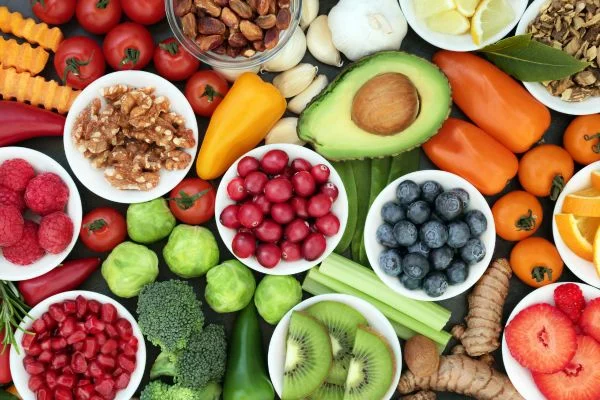What Is Food, Really?
What exactly is food anyway? Take a moment and write down your first answer. I’ll wait…
When I once asked this question to a group of middle-school students, the first answer was:
- “Whatever you put in your mouth to eat.”
Then another student added:
- “It must provide energy.”
Even with adults, most people still hold these same two ideas. The first, because our food choices are often driven by convenience and the need to curb hunger. The second, because we’re fixated on calories as “bad” and “fattening.”
The result? A diet full of fast, convenient, inexpensive, low-calorie foods – often eaten with guilt and remorse.
A Better Definition of Food
An accurate definition of food is:
“Substance in the body that sustains growth, repair, and vital processes and provides energy.”
Before you eat something, ask:
- Is what I’m about to eat actually food?
- Will this benefit my health or rob me of energy and progress?
If you’re holding a donut, that moment of pause might change your decision.
(Of course, if the donut talks back, drop it and run.)
Introducing “Precision Cuisine”
“Precision Cuisine” is a term coined by Dr. Jack Barnathan. It describes a lifestyle of eating quality, enjoyable foods that serve the body well. Here are some guidelines to help build your own Precision Cuisine approach.
1. How Many Steps From the Field?
Ask: How many steps is this item from where it originally walked or grew?
All foods come from either animal or vegetable sources. The more processing steps it has gone through, the further it is from being truly nourishing.
Example:
A chicken nugget may technically come from chicken, but if it’s only 50% chicken, it’s far removed from its origin.
General Rule:
Choose foods that are no more than 3 to 4 steps from their origin. These are usually found around the outer perimeter of your grocery store – fresh produce, meats, dairy, and less processed items.
2. Read Labels Carefully
Avoid the following like the plague:
- High fructose corn syrup
- Modified soy products (e.g. soy protein isolates)
- Hydrogenated or fractionated oils (trans fats)
- Artificial sweeteners (e.g. aspartame)
- Ingredients that are hard to pronounce
- Abbreviated additives (e.g. BHT)
- Artificial colours (e.g. red 3, red 40, yellow 5)
These often signal ultra-processed foods that undermine health.
Go Organic
Yes, it’s more expensive – but think of it as paying for concentrated nutrition.
A free-range organic egg may have up to three times the nutrients of a conventional one. Organic meat is free from synthetic hormones, antibiotics, and grain-induced toxins.
Key concerns with non-organic foods:
- GMO produce is bred for size and durability, not nutrition.
- GMO plants may lack natural defences and antioxidants.
- Oil-based pesticides, fungicides, and herbicides don’t wash off with water.
- Fertilisers (PNK – phosphorus, nitrogen, potassium) are sometimes sourced from industrial waste, including toxic and even radioactive materials.
Recommended Reading:
Fateful Harvest by Duff Wilson exposes the toxic fertilizer industry in detail.
The Whole Truth About Grains
Grains are seeds of grasses, often called cereals. Whole grains retain their bran and germ – the parts richest in fibre and nutrients.
Refined grains, such as white bread or white rice, have these parts removed, stripping them of most of their nutritional value. These refined products are then “fortified” with synthetic vitamins to meet legal standards.
Watch out for misleading labels:
“100% wheat,” “stone ground,” and “multi-grain” don’t guarantee you’re eating whole grain.
Look for “whole grain” as the first ingredient.
Benefits of whole grains:
- Reduce risk of stroke, heart disease, and type 2 diabetes
- Help with sustainable weight loss
- Provide long-lasting energy
The Skinny on Fats
Not all fats are bad. Some are essential for health and must be consumed through diet.
Monounsaturated and Polyunsaturated Fats
These “good fats” support brain function and growth. The essential ones are:
- Omega-3s – found in whole grains, legumes, fish, nuts, seeds, and leafy greens
- Omega-6s – found in oils like corn, safflower, soybean, and sunflower
Balanced ratio matters:
Historically, we consumed omega-6 to omega-3 at a 2:1 ratio. Today, it’s 10-20:1, leading to:
- Increased inflammation
- Insulin resistance
- Higher cancer risk
- Aggravation of conditions like arthritis and psoriasis
Healthy oils: Olive oil, coconut oil
Saturated Fats
These are mostly animal-based and solid at room temperature (butter, lard, fatty meats).
While blamed for heart disease, the problem may be imbalance, not presence.
Meat should be a complement, not the centrepiece of a meal.
Tip: Include organ meats – nutrient-dense and traditionally part of a wholesome diet.
Trans Fats
These man-made fats are found in:
- Fried foods
- Processed snacks
- Packaged baked goods
Labeled as: Hydrogenated oils or “trans fats”
They:
- Lower good cholesterol (HDL)
- Raise bad cholesterol (LDL)
- Increase risk of heart disease and stroke
- Are not recognised by the body and treated as toxins
White Carbs
White bread, white rice, processed sugar, white pasta, and potatoes are high glycaemic and convert rapidly to sugar.
Consequences:
- Insulin spikes and crashes
- Fat storage
- Insulin burnout
- Nutritional depletion
Manufacturers “fortify” them with synthetic vitamins, but that doesn’t make them healthy.
Refer back to “The Whole Truth About Grains” for more.
Energy Drinks
These products overstimulate your metabolism and adrenal system.
Health risks:
- Blood thickening (linked to stroke)
- Heart attack
- Increased risk of blood clots
- Adrenal burnout
Truth bomb:
Energy drinks don’t give you energy – they overdrive your stress response. If you’re tired, the real answer may be:
- More sleep
- Better hydration
- Less stress
- Improved nutrition
If those sound difficult to implement, it might be time to reassess your lifestyle altogether.





